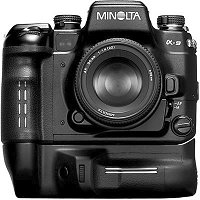photo equipment
In a time when the digital world grows you should know that I still use analog gear. Further, I am not
planing to go digital yet. Many of my frieds are fascinated in amateur DSLRs with resolution of 12 Mpix or such but I did not find it
interesting. Of course there are professional cameras like Sony Alpha 900 but I still prefer color transparency films.
So, all the pictures were shot on reversal films, developed in the lab, then scanned and finally tweaked by the imaging software. Black and
White negatives I process myself. To get the best possible image quality on a 35mm camera I use only fixed focal lenght lenses. The camera
body is less important than lenses, but there are three fetures that each camera just must have. First of all, a good exposure metering
system providing a spot and center weighted average (or just reliable matrix) modes. Minolta's honeycomb pattern is fine. Second,
exposure compensation system or manual mode. It is very important and useful feature. Third, remote control terminal or
sensor. That is all, other features of modern SLRs are either useless or less important in landscape photography. Another thing is a good
light meter, with a 1° spot meter and an incident light measurement. My favorite light meter
is Sekonic Digitalmaster L-758DR. I almost forgot about tripods to prevent blur. A solid one, made of metal e.g. Goldphoto or Manfrotto
equipped with the ball head is the best choice, I am sure.
camera body

exposure metering
Like most of landscape photographers I only use slow ISO 50 and medium ISO 100 reversal films. My favorite slides are Fuji
Velvia 50, Fuji Provia 100F and Kodak E100VS. The first one is the sharpest film available on the market,
while the last one is the most saturated. Dynamic range of all mentioned films is around 5.5EV, according to the straight
line of characteristic curves of each film. Because of narrow latitude (usually 0.7EV) slides are very sensitive to
the incorrect exposure. Overexposed material is lost, underexposed a little bit might be saved. Before taking photo I
measure the scene with the light meter (spot metering). So, at least two areas of the future image are considered, the brightest
and the darkest. If the dynamic range of the measured scene is over 5.5EV I just walk away. Otherwise, I mount the camera on a
tripod, compose and switch to the center weighted average metering mode. Then I observe results and if the brightest area is
no more that 2.5EV over that spot measured I either decide to adjust the exposure or to shot. Range of adjustment is from
0.5EV to 0.7EV (e.g. snow or mist covered area). For close ups I prefer incident light measurement. While taking photos
I make one or two exposures, hardly three (especially at sunrise or sunset when I bracket the scene). To get the correct exposure
I try to avoid the harsh light. It might cause the image to burn out some parts of it and eventually ruin the whole work by losing
details and colors in highlights.
lenses
As I said only fixed focal lenght lenses are mounted on my camera body. For the landscape work I mainly use four lenses, as
follows:
- Minolta AF 28/2
- Minolta AF 35/1.4G
- Minolta AF 50/2.8 Macro
- Minolta AF 100/2.8 Macro
scans & prints
All scans presented on the website are done by Marcin Krynski on Nikon Colscan 5000ED at PFC Multimedia Poznan. The medium-format transparency films are
scanned on Nikon Colscan 9000ED. Medium and large size prints are crafted by Marcin Luczyk at Print Shop Szczecin, Poland.